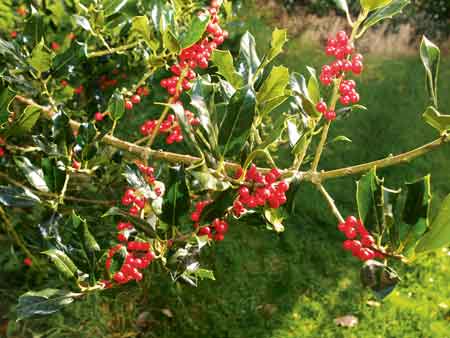Meet the holly growers

With Christmas approaching and halls across the country about to be decked with holly, Debbie James visits one amazing collection of the plants
Much folklore and superstition surrounds the holly tree, but one tale does seem to be founded in fact. It is said that if a mistle thrush nests near a holly tree, it will keep its plump red berries long into the winter.
Growers Tony and Pat Barnes were unconvinced until last season when they had an abundance of berries in their orchard well into January and concluded that the mistle thrush nesting there was to thank for the bumper crop by keeping hungry birds at bay.
“In January, redwings arrived by the many score and, within 24 hours, all the berries had been eaten. This year we have no mistle thrush and very few berries,” says Tony.
The Barnes’ have spent more than 20 years nurturing a national collection of holly, comprised of more than 800 plants.
When Tony and Pat moved to Pembrokeshire in 1986, their home had no garden. There was not a holly tree to be seen. They knew they would struggle to create a formal garden at Ffynnon because the land they had bought was largely unfenced and their sheep grazed right up to their front door. At the top of Pat’s Christmas wish list was a holly orchard. The six plants she was given were not quite what she had in mind, but into the ground they went.
Two decades later, there are an incredible 230 different varieties set in five acres and the garden is designed by Plant Heritage, the charity formerly known as the National Council for the Conservation of Plants and Gardens, as a national collection.
To be designated as such, there has to be a wide range of a particular genus and inspections are carried out by Plant Heritage. There are many criteria associated with national collections of plants and, like every other owner of these in the UK, the Barnes maintain theirs voluntarily.
Susyn Andrews, regarded as the ‘Queen of Holly’ because of her extensive knowledge of the species, spent three days inspecting every plant in their orchard at Cilgwyn, near Newport.
“Every plant is given an accession number and there is a detailed record on an A4 sheet of paper of each one,” says Pat. “This number is given to each at planting so that it can be identified.” The Barnes’ record the growth pattern of each plant.
It costs them time and money to maintain the orchard, but they do it for their own interest. Tony has had a lifelong interest in plants. If he had not become a transplant surgeon, he would probably have been a horticulturist.
By establishing their collection in Pembrokeshire, Tony and Pat had a challenge on their hands from the start because the mild maritime climate isn’t the best for growing holly.
Many of the varieties were cultivated in America where they acclimatised to the temperature extremes.
“Not all do well here, certain varieties just won’t grow,” Tony admits. “We lost one last year which was a variety from the south eastern United States where temperatures range from minus 40 degrees C in the winter to 35 degrees C in the summer.”
Many of the varieties in their garden at Fachongle Ganol were not available commercially so they were given permission to take cuttings from two other national collections – at Windsor Great Park and Kew.
“We had reached a point where we couldn’t buy any more varieties in nurseries and made arrangements to gather cuttings,” says Tony.
Holly is not the easiest cutting to root, but once established they remain in pots for three years. They are then planted in the ground where they do very little for another three years before their growth takes off.
“They grow quicker here than at Kew because it is wetter, but they probably grow too quickly. Their wood can be soft after rapid growth,” says Pat.
Despite being a firm favourite on Christmas cards, there is only one species of holly native to the UK. The Aquifolium, a hedge holly, is a maritime species which would not stand temperature extremes.
Tony and Pat are both agreed upon their favourite – Japanese Crenata, a species which can have small black or white berries, small leaves and can be used in topiary.

In the UK holly is, of course, used mainly as a Christmas decoration but other parts of the world are more adventurous. The North American Indians make a tea from it, which predictably induces vomiting and so is regarded as a means of cleansing the body. “We have never tried it and wouldn’t recommend anyone else should either!” says Tony.
The market for holly at Christmas has got smaller in recent years with more people favouring imitation varieties, but turn the clock back 150 years and a quarter of a million bunches would leave Pembrokeshire every December to be sold at Covent Garden.
“When the railways opened up, a huge quantity of holly and rabbits would be transported to London to be sold,” says Tony.
He would probably be pleased if a few rabbits were still bundled onto trains because they are not a friend of the holly and have munched their way through a number of young plants at Fachongle Ganol even those with prickly leaves.
Although many of us associate holly with having spiky leaves, very few varieties in fact do. One that does though is the species native to the UK.
Tony is surprised that more use isn’t made of this plant in hedging schemes. “I never understand why highway authorities don’t use it more in landscaping schemes. It is a native species, looks nice and is of course useful as a barrier.”
Looking after his own landscape keeps Tony very busy. The grass area alone takes seven hours to mow in the summer. “We didn’t start playing golf or bridge when we retired and people ask us what we do with our time. Our garden keeps us very busy.”
The history of the holly tree |
|---|
According to legend, the holly bush holds extreme powers by protecting homes from evil spells. The red-coloured berries, like those of the hawthorn and the mountain ash, are said to ward off evil spirits. In early Christian times, there was a belief that the leathery, spiny leaves of the holly were a symbol of the Crown of Thorns, while the red berries represented the blood of Christ. Holly’s association with Christmas dates back to pagan times when it was considered good luck to bring something green and living into the house in the depths of winter. In years past, farmers used holly for cart axles and to stop witches from flying along the hedgerows. |
